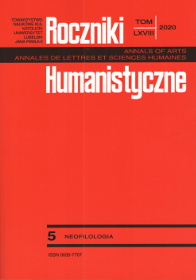Gendering the Holocaust: Robert McLiam Wilson’s Manfred’s Pain and Marek Soból’s Mojry
Abstrakt
Płeć Holokaustu: Autopsja Roberta McLiama Wilsona i Mojry Marka Sobola
Artykuł analizuje dwie powieści dotyczące Zagłady: Manfred’s Pain, czyli (w polskim przekladzie) Autopsję (1992), północno-irlandzkiego pisarza Roberta McLiama Wilsona i Mojry (2005) polskiego autora Marka Sobola jako przykłady prozy skoncentrowanej na kobiecym ciele, kobiecej wrażliwości i kobiecej wersji historii. Obie powieści wiążą ten temat z przemocą seksualną i podkreślają specyfikę kobiecego doświadczenia Holokaustu. Artykuł dowodzi, że spojrzenie na Zagładę z perspektywy płci i przedstawienie jej ‘kobiecej’ strony stanowi swoiste novum odróżniające te powieści od innych, zwykle ‘męskich’ narracji Holocaustu w literaturze polskiej i bardzo ‘męskich’ powieści Wilsona. Męskie doświadczenie, zwykle naturalizowane jako uniwersalnie ludzkie, jest przemieszczone w tych dwóch powieściach w kierunku kobiecej perspektywy. W przypadku Autopsji dokonuje się to poprzez zmianę proporcji: chociaż bohaterem i narratorem powieści jest mężczyzna, a postać kobieca stanowi zaledwie tło, to ta ostatnia okazuje się bohaterką równie ważną, a jej doświadczenie równorzędne z męskim. W powieści Sobola role są już odwrócone: to kobiece postaci wysuwają się na pierwszy plan jako bohaterki i narratorki, a opowiadania prezentują ich doświadczenie i ich punkt widzenia, przeznaczając dla męskich postaci rolę świadków. Skupiając się na losach kobiet, oba teksty opowiadają pozornie uniwersalne doświadczenie Holocaustu z perspektywy płci, zwracając uwagę również na jego płciowe uwikłanie.
Bibliografia
Benigni, Roberto, dir. Life Is Beautiful. Perf. Roberto Benigni and Nicoletta Braschi. Melampo Cinematographica, 1997.
Ejchenbaum, B[oris] M[ikhajlovich]. “Iluzja narracji mówionej.” Rosyjska szkoła stylistyki, edited by Maria Renata Mayenowa and Zygmunt Saloni, Państwowy Instytut Wydawniczy, 1970: 487-488.
Ejchenbaum, B[oris] M[ikhajlovich]. “Jak jest zrobiony Płaszcz Gogola.” Rosyjska szkoła stylistyki, edited by Maria Renata Mayenowa and Zygmunt Saloni, Państwowy Instytut Wydawniczy, 1970: 489-490.
Fanon, Frantz. Wyklęty lud ziemi. Translated by Hanna Tygielska, Państwowy Instytut Wydawniczy, 1985.
Jacobson, Howard. J. Jonathan Cape, 2014.
Kędra-Kardela, Anna. “The Theme of Trauma in Elizabeth Bowen’s War Stories.” Margins and Centres Reconsidered, edited by Barbara Klonowska and Zofia Kolbuszewska, Towarzystwo Naukowe KUL, 2008, pp. 49-56.
Magennis, Caroline. Sons of Ulster. Masculinity in the Contemporary Northern Irish Novel. Peter Lang, 2011.
Onega, Susana, and Jean-Michel Ganteau. “Traumatic Realism and Romance in Contemporary British Narrative.” Trauma and Romance in Contemporary British Literature, edited by Jean-Michel Ganteau and Susana Onega, Routledge, 2013, pp. 1-13.
Ostachowicz, Igor. Noc żywych Żydów. Wydawnictwo W. A. B., 2012.
Paziński, Piotr. Pensjonat. Wydawnictwo Nisza, 2009.
Soból, Marek. Mojry. Wydawnictwo W. A. B., 2005.
Szewc, Piotr. Zagłada. Wydawnictwo Literackie, 1987
Thomas, D.M. The White Hotel. Penguin, 1981.
Wilson, Robert McLiam. Manfred’s Pain. Picador, 1992.
Copyright (c) 2020 Roczniki Humanistyczne

Utwór dostępny jest na licencji Creative Commons Uznanie autorstwa – Użycie niekomercyjne – Bez utworów zależnych 4.0 Międzynarodowe.





